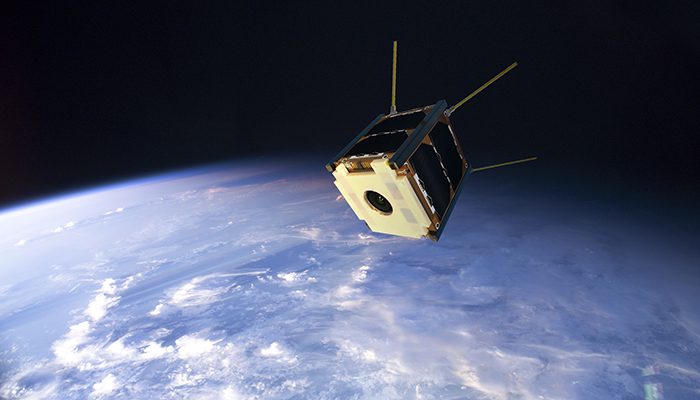The long wait is over – Suomi 100 satellite finally on its way to be launched
Probable launch date of mid-November for satellite that will make observations of space weather and aurora borealis.

Happy team members (from back) Petri Koskimaa Aalto University, Antti Kestilä Finnish Meteorological Institute and Arno Alho Aalto University. Photo: Jari Mäkinen
The long-delayed journey into space of the Suomi 100 satellite is now beginning: the satellite was delivered this Wednesday (12 September) to the launch service provider in Holland, and the launch will take place using a Falcon 9 carrier rocket in mid-November.
The development work on the satellite, which was named in honour of Finland’s 100-year jubilee, was lead by Aalto University in co-operation with the Finnish Meteorological Institute. The satellite’s journey was delayed by almost a year due to problems with the Indian PSLV carrier rocket which was originally chosen for the launch. Since solving the problems, the Indian space agency have accepted only commercially or strategically important satellites for their carrier rockets, so Aalto University began to look for other options together with its Dutch launch service provider.
The Falcon 9 will be launched into space from California, from SpaceX’s launch site located at the Vandenberg air base. The site is located on the Pacific coast around 250 km to the north-west of Los Angeles. In addition to the Suomi 100 satellite, around 100 other nanosatellites will be travelling into space on the Falcon 9.
‘This is very good news, because we want to get the satellite into space as soon as possible’, says the project's leader Professor Esa Kallio from Aalto University.
‘We got the satellite ready in good time last year, so having to delay its launch until this year was a great pity to both us and the Suomi 100 project. We will thus now be celebrating Finland in retrospect.’
The Falcon 9 had a couple of accidents several years ago. Following these the rocket has nevertheless functioned well, and at its best it has been able to make flights every other week. Based on the statistics, the Falcon 9 is in fact a slightly more reliable carrier rocket than the PSLV: Its launches have a success rate of nearly 97%, compared to 93% for the PSLV.
A special feature of the Falcon 9 is that it is partly reusable: the rocket’s first stage, which it uses to take off and which is the rocket’s largest and most expensive part, returns back to earth after launch and can be used again. It seems, however, that the launch of the Suomi 100 satellite will be carried out using a new rocket stage.
More satellites already under construction
With its specially manufactured radio equipment, the Suomi 100 satellite will be measuring the space weather in inner space at an altitude of around 500 km. In addition, the satellite’s camera will be recording visible space weather phenomena, such as the northern lights, as well as the planet itself and Finland in particular.
‘From a research perspective, launching now during a period of minimal solar activity is interesting because we will get to make space weather measurements at the same time as the solar activity starts to increase again’, mentions Professor Kallio.

Illustration of Suomi 100 satellite in space.
The Finnish Meteorological Institute, as the other body responsible for the satellite, will also participate in the processing and analysis of the scientific observations made by the Suomi 100 satellite.
The satellite will also test out the durability in space conditions of a new kind of 3D-printed plastic structure developed at Aalto University and also the utilisation of artificial intelligence in a nanosatellite.
The Suomi 100 satellite has been waiting it out in the Otaniemi clean room, where further improvements have been made to the satellite and its computer programming. At the same time, aspects such as antenna guidance and station remote guidance have been developed at the Otaniemi earth station.
A significant portion of the funding for the satellite was obtained from the Suomi 100 Jubilee Foundation. The project also included the ‘Space Lorry’, which travelled around Finland in September and October last year presenting both the Suomi 100 satellite and also more widely the new space expertise related to Finnish nanosatellites.
In addition to Suomi 100, Aalto University has also constructed two other nanosatellites: The Aalto-2 satellite launched in April 2017, and the Aalto-1 (whose mission still continues) which was launched on Midsummer 2017. There are currently three new satellites in development, of which the first (Aalto-3) is due to be launched towards the end of next year.
Inquiries:
Professor Esa Kallio
tel. +358 50 420 5857
esa.kallio@aalto.fi


